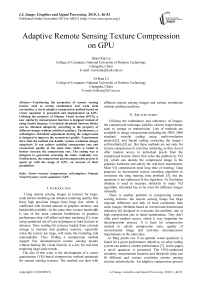Adaptive Remote Sensing Texture Compression on GPU
Автор: Xiao-Xia Lu, Si-Kun Li
Журнал: International Journal of Image, Graphics and Signal Processing(IJIGSP) @ijigsp
Статья в выпуске: 1 vol.2, 2010 года.
Бесплатный доступ
Considering the properties of remote sensing texture such as strong randomness and weak local correlation, a novel adaptive compression method based on vector quantizer is presented and implemented on GPU. Utilizing the property of Human Visual System (HVS), a new similarity measurement function is designed instead of using Euclid distance. Correlated threshold between blocks can be obtained adaptively according to the property of different images without artificial auxiliary. Furthermore, a self-adaptive threshold adjustment during the compression is designed to improve the reconstruct quality. Experiments show that the method can handle various resolution images adaptively. It can achieve satisfied compression rate and reconstruct quality at the same time. Index is coded to further increase the compression rate. The coding way is designed to guarantee accessing the index randomly too. Furthermore, the compression and decompression process is speed up with the usage of GPU, on account of their parallelism.
Texture compression, self-adaptive, Human Visual System, vector quantizer, GPU
Короткий адрес: https://sciup.org/15012029
IDR: 15012029
Список литературы Adaptive Remote Sensing Texture Compression on GPU
- K. Roimela, T. Aarnio and J. Itäranta, “Efficient high dynamic range texture compression,” in Proc. of the 2008 symposium on Interactive 3D graphics and games, Redwood city, California, 2008, pp. 207-214.
- J. Wang, T. T. Wong, P. A. Heng, and C. S. Leung, “Discrete wavelet transform on GPU,” in Proc. ACM Workshop General-Purpose Computing on Graphics Processors, 2004. pp. C–41.
- H. Jiao, G. Chen, “A color image fractal compression coding method,” Journal of Software, vol. 14(4), pp. 864-868, 2003.
- A. C. Beers, M..Agrawala, N. Chaddha, “Rendering from compressed textures,” in Proc. of ACM SIGGRAPH, New Orleans, Louisiana, 1996, pp. 373-378.
- Y. Tang, H. X. Zhang, M. Y. Zhang, “GPU-based texture encoding and real-time rendering,” Chinese Journal of Computers, vol. 30(2), pp. 272-280, 2007.
- C. Zhao, W. Chen, L. Zhang, “A compression algorithm of hyper spectral remote sensing image based on vector quantization,” Journal of Harbin Engineering University, vol. 27(3), pp. 843-848, 2006.
- A. P. Berg, and W. B. Mikhael, “A survey of mixed transform techniques for speech and image coding, ” in Proc. of the IEEE International Symposium on Circuits and Systems(ISCAS ’99), 1999, vol. 4, pp. 106-109.
- I. Heynderickx, E. Langendijk, “Image-quality comparison of PDPs, LCDs, CRTs and LCoS projection displays,” In Proc. of SID, Boston, 2005, pp. 1502-1505.
- Toet A., Van Ruyven L. J., Valeton J. M. 1989. Merging Thermal and Visual Images by a Contrast Pyramid. Optical Engineering, 28, 7(Jul.), 789-792.
- Wang Y. 2009. http://baike.bbioo.com/doc-view-414.htm
- Z. Wang, A. C. Bovik, “Mean Squared Error: Love it or leave it?,” IEEE Signal Processing Magazine, vol. 26, (1), pp. 98-117, 2009.
- “NASA Terra satellite remote sensing image,” http://modis.gsfc.nasa.gov/galiery. 2009, Feb.
- “QuickBird satellite remote sensing image,” http://www.digitalglobe.com/. 2004.
- Yu Y. D., Kang D. S., Kim D. 1999. Color image compression based on vector quantization using PCA and LEBLD. In Proceedings of the IEEE Region 10 Conference(TENCON 99), Cheju island, South Korea, 2, 1259-1262.
- NVDIA CUDA Programming Guide. http://www.nvidia.com/object/cuda_develop.html, 2007.


